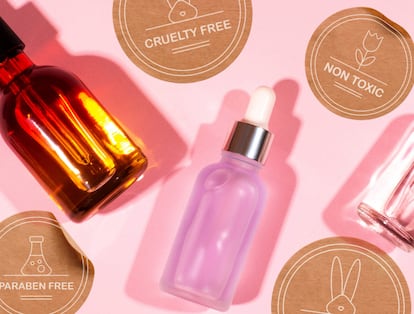From ‘anti-cellulite’ to ‘paraben-free’: Debunking the 10 biggest lies that the beauty industry would like us to believe
Cosmetic companies have been using half-truths, empty promises and misleading claims to sell their products for years

Driven by an undeniable and understandable need to sell, cosmetics companies use the most powerful claims they can in order to market their products, often confusing us in the process. For our part, consumers are crucial to the law of supply and demand that governs the cosmetics industry; we generate the demand. With a little digging, we find that product claims are not entirely truthful, and some are outright deceptive. But information is power, and we can use it to avoid being misled by the litany of myths and slogans that keep us from freely and wisely choosing which cosmetics we use. Below, we debunk the beauty industry’s most common deceptive claims.
1. Cruelty-free
The bunny seal has existed, and been questioned, for many years. According to Google Trends, the symbol started to gain popularity in 2016, but is “cruelty free “a helpful claim? Dr. Natalia Jiménez, a dermatologist and member of the Spanish Aesthetic and Therapeutic Dermatology Group, says no. “Testing on animals has been prohibited in the European Union since 2013, so putting this logo on cosmetic products is redundant and inadvisable,” she notes.
But there is more to the issue than meets the eye: although a seal that indicates that a product has been created without cruelty to animals is unnecessary in Europe, the United States, and Latin America, and can be unfair and harmful to other brands, many companies still want to use it. Why?
As Amparo Violero–a biologist and specialist in the science of cosmetics, who discusses beauty products on social media (@nuclear.beauty)–explains: “Tests [on animals] can be done for cosmetics that are going to be marketed outside the European Union and…for other purposes, such as pharmaceuticals. The regulation does not take these cases into account, and that’s the issue: the fact that a brand is physically present in China does not mean that it isn’t cruelty free, but it can still happen and be perfectly legal; …there is also evidence that…certain legal loopholes… make it possible to include ingredients in cosmetics that have been tested on animals in the EU.”
She believes that “consumers want to be able to distinguish whether a brand is generally aligned with their values globally, not whether a particular formula hasn’t been tested in the European Union. The authorities’ failure to recommend the cruelty-free claim overlooks that demand,” she says. “Thus, the claim continues to be used, in a more or less explanatory way, by some brands that voluntarily decide that…their products or ingredients will not undergo such testing anywhere in the world.”
In this case, the brands, the cosmetics industry and even the law tell half-truths. Violero points out that the labels may also be misleading: “certificates from external companies that facilitate the use of a logo do not 100% guarantee that a product is cruelty-free around the world; sometimes, the audits they perform are superficial.” She also notes that testing on animals “is not simple nor is it done on a daily basis in cosmetics in the EU…some brands also fail here because they do not tell the whole story and make it seem that [testing on animals] happens daily.” Finally, she advises that “a cruelty-free product doesn’t mean that it is vegan.”
2. Non-toxic
“There are no toxic cosmetics on the market. Nor are there any products that lack natural origins. All products pass strict safety measures, so [non-toxic claims] are unnecessary,” says Dr. Jiménez. Here, the cosmetics industry is engaging in fearmongering. To promote and popularize natural or organic products, companies use false claims to discredit other products.
Violero agrees: “There is no doubt here: [the fact] that a product does not contain toxins just means it is complying with the legislation…cosmetics with toxic ingredients (according to the evidence we currently have) cannot be marketed in the European Union: by law, all products must be safe. Some opportunistic brands claim to be ‘non-toxic’ in an effort to cause fear, a powerful emotion that generates a lot of sales.”
3. Sulfate-free/Paraben-free
If toxins are justly but unnecessarily demonized, sulfates and parabens are vilified both unnecessarily and unfairly. “Claims of ‘being free [of a certain ingredient]’ became trendy a few years ago…they have been used and abused,” says Amparo Violero. “Some claims are justified, and many others are illegal and make no sense at all.”
The experts point out that the claim ‘sulfate-free’ may be warranted for some products, such as low-detergent shampoos or specific cleansers for atopic skin because both products typically contain sulfates. However, such an assertion “would not make sense for face creams, for example, since none of them contain sulfates [in the first place],” says Violero. That’s true for parabens as well: a claim like that “would not be legal, because it denigrates a group of ingredients that, to date, the authorities consider safe.”
4. Oil-free
This is another half-truth. A product may be free of oils, but it is not usually necessary to avoid them. Are all oil-free products suitable for acne-prone skin? Are all oils comedogenic? “The answer is clear: no,” says Celia Martínez, a pharmacist, expert in dermatological cosmetics and formulation and the creator of the ThePorefectSkin. “Although it is used as a claim to draw the attention [of those with] oily or acne-prone skin, there are products that contain oils–such as jojoba, argan or rosehip oils–that can work well on all types of acne-prone skin and won’t clog pores,” she adds.
People associate the oil in products with more oil in the skin and think that those who have oily skin should only use oil-free products, but that’s not necessarily true: “There are oils that tend to work well on oily skin, such as almond or avocado oil, especially when cleansing the face,” says Dr. Jiménez.
5. Non-comedogenic
Much like the previous claim, “non-comedogenic” frequently appears and enjoys great success among people with combination or oily skin. “It is an extremely relative claim. That’s why it’s not legislated; the tests that are performed are too random, like testing [a product] on people the product is not intended for or testing it on areas of the body where it is not going to be applied,” points out Martínez.
So, why is the claim used? Dr. Jiménez explains that “[it] is usually based on the fact that the ingredients aren’t comedogenic individually. But we cannot be sure that they won’t produce comedones or acne…in some people. Current legislation does not require a final test of the entire product’s comedogenicity.”
For that reason, all of the experts consulted for this article recommended disregarding the non-comedogenic claim: “Whether a skin care product is potentially comedogenic for someone or not depends on many factors, like lifestyle, environmental conditions, and the skin itself…Here, one of the most hackneyed phrases in the skincare universe applies: ‘each person’s skin is different,’” Celia Martínez summarizes.
6. Treats/prevents acne
To properly understand why this assertion is confusing, we must begin by making it clear that, when we’re discussing acne, we are talking about a disease that requires medical treatment. “No cosmetic product should explicitly or implicitly claim to treat or prevent a disease. That’s the purview of medical devices and drugs,” warns Amparo Violero. Dr. Jiménez concurs: “That is the sole and exclusive role of drugs. On the other hand, a cosmetic can indeed claim to improve the appearance of acne-prone skin.”
Violero adds that “the same goes for products that claim to treat atopic dermatitis, psoriasis, rosacea or melasma: these are all skin diseases. They would all be illegal claims. When I see these kinds of claims, I run away from the brand: if they don’t pay attention to the regulatory part, which is of paramount importance, I can’t take [the company] seriously.”
7. Anti-wrinkle/anti-dark spot
“‘Anti-wrinkle’ or ‘anti-dark spot’ claims lead us to believe that we can actually erase wrinkles or already existing dark spots with a cosmetic product. But the truth is that not even proven active ingredients like retinol can achieve that: we can only smooth them out or delay their onset, to some extent,” says Natalia Jiménez.
These two claims appear constantly in marketing campaigns and on the packages, and even promise timeframes for achieving these effects, but all signs point to the fact that they’re lying to us. “When I read ‘dramatically reduces wrinkles or dark spots in 10 days,’ I don’t trust it one bit. For starters, it takes the skin about 28 days to renew itself. That’s the minimum time it would take to see noticeable results,” Martinez explains. “If you want to [get rid of] any wrinkles, you’re going to have to go to a cosmetic dermatologist and have fillers and Botox,” she adds. “The same goes for blemishes, like melasma: [dark spots] might get lighter, but in the vast majority of cases, they need to be treated by a dermatologist with lasers or intense pulsed light treatment to be eliminated,” Dr. Jiménez points out.
8. Stimulates hair growth
More than any other need, stimulating hair growth is essential for men and women; we are all so afraid to see hair fall out. However, we are talking about a pathology that can only be treated with medication. “Cosmetics cannot do what only drugs have been proven to do. A cosmetic product can only improve the hair’s appearance, like [imparting] shine,” Jiménez explains.
Once again, legal terminology is important: “No cosmetic product or its ingredients should be restoring, correcting or modifying physiological functions through pharmacological, immunological or metabolic action. Thus, claiming that a cosmetic product ‘stimulates hair growth’ would either be untrue or highly problematic and put the product’s [manufacturer] on the defensive. The brand would have to thoroughly explain how it would achieve this [result] without doing [those things], as well as why the product isn’t classified as a drug,” says Amparo Violero.
9. Anti-cellulite
“Legend has it that by using the same cream the celebrity du jour is using, you can lose five centimeters of thigh in a month,” jokes Celia Martínez. “It’s already very difficult to get rid of fat by exercising and eating a balanced diet, so to [put our faith] in cosmetics [to remove] our accumulations of adipocytes” doesn’t make sense, she points out. The reason, she observes, is simple: “Assuming that you won’t see any results if you don’t lead a healthy and active life, what really works with the creams is the draining massage that you’re doing when you apply them, which is the only thing that mobilizes the fat.
All the experts consulted for this article agree: “Cellulite cannot be removed.” So why are there so many ‘anti-cellulite’ products and testimonials attesting to their effectiveness? “There are active ingredients in these cosmetics that…help to improve circulation (such as caffeine, horse chestnut, green tea or carnitine), an essential process for reducing cellulite,” explains Martínez.
10. Firming
Products that claim to firm up the face are similar to products that say they eliminate cellulite. “When we say that a cosmetic firms [the skin], we think of an obvious tightening effect, which is difficult to achieve,” Dr. Jiménez explains. The experts all point out that a cream cannot firm your skin.
“Firmness, which basically means that the skin stays in place and does not sag, comes from the dermis, where … collagen and elastin are found; after the age of 25, we produce them at a slower rate. But cosmetics rarely reach the dermis,” Celia Martínez explains.
However, there are active ingredients that can help: “For example, retinol, peptides and hydroxy acids have been shown to enhance collagen production. But that doesn’t mean that we can compare their effects to those we would get through cosmetic medical procedures,” Dr. Jiménez says.
Sign up for our weekly newsletter to get more English-language news coverage from EL PAÍS USA Edition
Tu suscripción se está usando en otro dispositivo
¿Quieres añadir otro usuario a tu suscripción?
Si continúas leyendo en este dispositivo, no se podrá leer en el otro.
FlechaTu suscripción se está usando en otro dispositivo y solo puedes acceder a EL PAÍS desde un dispositivo a la vez.
Si quieres compartir tu cuenta, cambia tu suscripción a la modalidad Premium, así podrás añadir otro usuario. Cada uno accederá con su propia cuenta de email, lo que os permitirá personalizar vuestra experiencia en EL PAÍS.
¿Tienes una suscripción de empresa? Accede aquí para contratar más cuentas.
En el caso de no saber quién está usando tu cuenta, te recomendamos cambiar tu contraseña aquí.
Si decides continuar compartiendo tu cuenta, este mensaje se mostrará en tu dispositivo y en el de la otra persona que está usando tu cuenta de forma indefinida, afectando a tu experiencia de lectura. Puedes consultar aquí los términos y condiciones de la suscripción digital.
More information
Últimas noticias
Welcome to the post-religion era: The idea of Christianity as the absolute truth has become obsolete
‘I thought you would like it’: The risky sexual practice popularized by TV shows and TikTok
The digitalization of tourism: ‘They promise experiences and gave us the worst possible one’
Mexican peso defies uncertainty with forecasts of a new period of stability in 2026
Most viewed
- Sinaloa Cartel war is taking its toll on Los Chapitos
- Oona Chaplin: ‘I told James Cameron that I was living in a treehouse and starting a permaculture project with a friend’
- Reinhard Genzel, Nobel laureate in physics: ‘One-minute videos will never give you the truth’
- Why the price of coffee has skyrocketed: from Brazilian plantations to specialty coffee houses
- Silver prices are going crazy: This is what’s fueling the rally











































